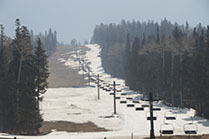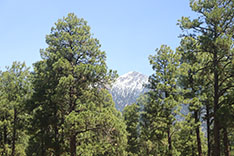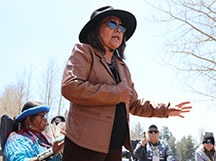 This is the 3rd in a series of feature stories on environmental topics by Knight Center students who attended the 2025 Society of Environmental Journalists conference.
This is the 3rd in a series of feature stories on environmental topics by Knight Center students who attended the 2025 Society of Environmental Journalists conference.
By Mia Litzenberg

Mia Litzenberg
When most people flush the toilet, the thought of where wastewater ends up goes down the drain.
At the Arizona Snowbowl Ski Resort, treated wastewater is used to create artificial snow that blankets the San Francisco Peaks – a sacred mountain to over a dozen Indigenous tribes.
“I was out here inspecting the area one time and some family with some kids were out here, and they were eating the snow,” said Diné activist Shawn Mulford.
Mulford said the parents had not noticed the sign saying the resort was using reclaimed wastewater that should not be drunk. Since the incident, Mulford said the sign was moved away from the entrance even further down the hillside.

An empty ski lift at the Arizona Snowbowl Ski Resort in April. Credit: Mia Litzenberg
Although the resort uses Grade A+ reclaimed water to make its snow, it does not pass drinking water standards.
The Indigenous tribes who have stewarded the sacred mountain, called Dookʼoʼoosłííd in Navajo, have harvested medicinal plants and held religious ceremonies there for thousands of years.
“My elders have been telling me ‘You can’t go harvest on the peaks anymore,’” said Ka-Voka Jackson from the Hualapai tribe. “We don’t know what’s in those plants – the drugs, the chemicals, hormones. Birth control is a big one that’s not something they can filter out or that they do.”

The San Francisco Peaks of Arizona. Credit: Mia Litzenberg
The Rio de Flag Wastewater Treatment Plant that supplies reclaimed water to Snowbowl does not have the technology to remove contaminants of emerging concern, according to the facility’s staff. These include pharmaceuticals, personal care products and PFAS, which are all classified as endocrine-disrupting compounds for their damaging effect on organisms.
In the 2008 Supreme Court case Navajo Nation v. United States Forest Service, the court ruled that “there are no plants, springs, natural resources, shrines with religious significance or religious ceremonies that would be physically affected by the use of such artificial snow.”
In 2023, retired U.S. Geological Survey research geologist Richard Hereford found that the reclaimed water runoff from Snowbowl was eroding gullies into Hart Prairie, which is outside of the ski resort’s permitted area.

Richard Hereford shares his research on reclaimed water runoff erosion and pollution at the Arizona Snowbowl Ski Resort. Credit: Mia Litzenberg
“It turns out the water’s extremely polluted,” said Hereford. “It’s nutrient-rich, which means it has high phosphorus and nitrogen content.”
Hereford’s research revealed that this chemical pollution through the production of artificial snow with reclaimed water has the potential to alter the prairie’s ecosystem.
“We’d never, ever said yes for them to make snow,” said Havasupai elder Dianna Sue White Dove Uqualla.
Uqualla also spoke about how interconnected issues, like mining and further development at Snowbowl without Indigenous consent, contributed to a gut-wrenching cycle of abusing the land.

Havasupai elder Dianna Sue White Dove Uqualla criticizes the federal government for making decisions about Snowbowl without Indigenous consent. Credit: Mia Litzenberg
“For us, Mother Earth is real, a woman,” said Uqualla. “We are raping Mother Earth.”
While the federal government is required to have meaningful consultation with Indigenous tribes when considering land management projects, the government has the power to make final decisions.
The U.S. has not adopted the standard of free, prior and informed consent in international law, which recognizes the right of Indigenous people to make their own decisions.
Through the meaningful consultation model, religious ties with the land are often neglected.

Navajo activist Cora Maxx-Phillips speaks to journalists about the religious significance of the San Francisco Peaks as a part of the Society of Environmental Journalists 2025 Conference. Credit: Mia Litzenberg
“We as Indigenous nations – the reason why we are the most misunderstood group of people on the face of this earth – is because we have such a strong emotional, spiritual, physical, connection with the earth and the universe, and that makes us an earth-based people with a strong astrophysical culture,” said Navajo activist Cora Maxx-Phillips.
“My ancestors, they shed tears like this,” said Maxx-Phillips as she wiped tears from her own eyes. “Saying that this place is holy and it’s sacred. Nobody paid attention. They left this world with their tears. To this day, we’re still shedding tears, but we’re not ready to give up and we will never give up.”
Jackson said the Indigenous people will continue to seek litigation in the fight to protect Dookʼoʼoosłííd.
“We’re going to find ways to use their systems against them, because that’s what we’re left with,” Jackson said.
“You don’t just destroy a whole sacred mountain, a holy mountain, so that a few people can go skiing or snowboarding, or come over here and throw snowballs with their kids, this isn’t the place for that,” Jackson said.
